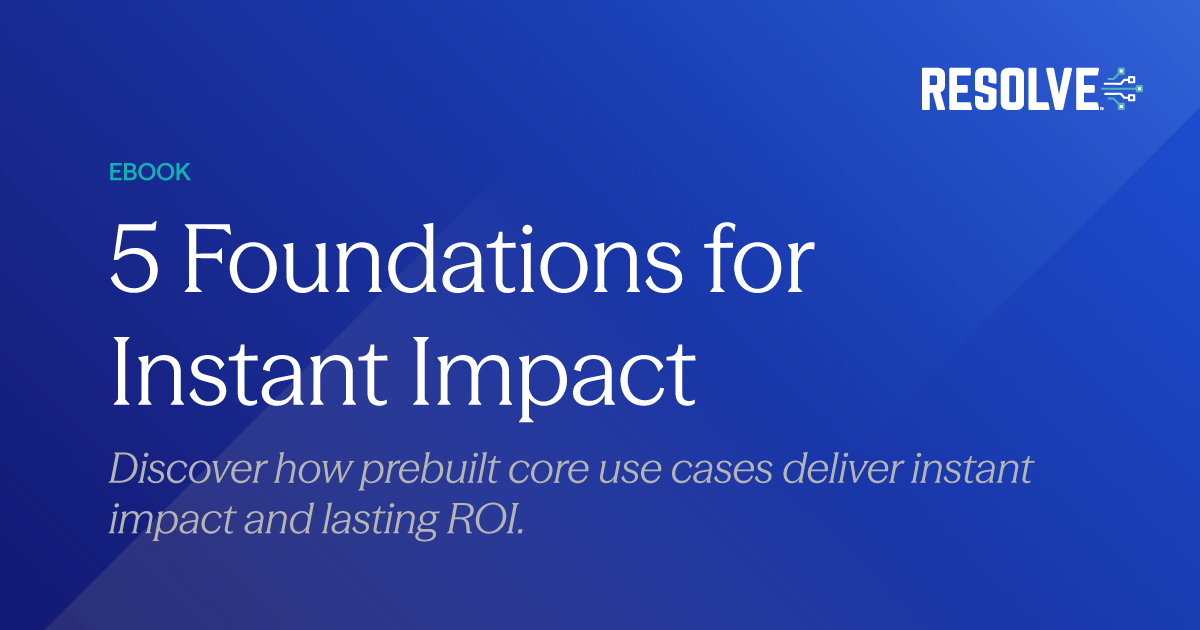
Future-Proof Your IT: Understanding Self-Healing IT Infrastructure
Subscribe to receive the latest content and invites to your inbox.
Today's businesses can’t afford downtime or disruptions in IT operations. This is where self-healing IT infrastructure comes into play.
Designed to proactively detect, diagnose, and resolve issues without manual intervention, self-healing systems are revolutionizing the way IT teams manage operations. But what exactly is self-healing IT infrastructure, and why does it matter? Let’s dive in.
What Is Self-Healing IT Infrastructure?
Self-healing IT infrastructure refers to a system that automatically identifies and resolves operational issues as they arise. They don’t require human input.
Imagine a network that detects a failing server and seamlessly reroutes traffic, or an application that restarts itself after a critical error. This is the promise of self-healing IT: a smarter, more resilient system that keeps businesses running smoothly.
Key Characteristics of Self-Healing Systems:
- Automation: Processes are automated to address errors in real-time.
- Proactive Monitoring: Systems are constantly observed for anomalies.
- Autonomous Decision-Making: Systems can make decisions and execute fixes without human intervention.
- Scalability: Easily integrates into existing infrastructure and scales as operations grow.
How Does Self-Healing IT Infrastructure Work?
At its core, self-healing IT infrastructure relies on automation, artificial intelligence (AI), and advanced monitoring tools.
Here’s a step-by-step breakdown of how it functions:
1. Proactive Monitoring
Systems continuously monitor performance metrics such as CPU usage, memory utilization, and application response times. Tools like observability platforms and monitoring dashboards help detect anomalies before they escalate.
2. Anomaly Detection
Using AI and machine learning (ML), self-healing systems identify patterns that indicate potential issues, such as slow performance or unusual activity spikes.
3. Root Cause Analysis
Once the system detects an anomaly, it performs root cause analysis (RCA) to pinpoint the underlying issue(s). This may involve analyzing logs, tracing errors, or evaluating dependencies.
4. Automated Resolution
Based on predefined rules or AI-driven insights, the system executes corrective actions like restarting a service, reallocating resources, or patching vulnerabilities, among others.
5. Feedback Loop
After resolving the issue, the system learns from the event, improving its ability to handle similar problems in the future.
Now that we’ve explored how self-healing IT systems work let’s understand why it’s become an absolute necessity in today’s digital landscape.
Why Do You Need Self-Healing IT Infrastructure?
The demands on IT systems are growing exponentially. Businesses need systems that can keep up, from handling millions of transactions to ensuring 24/7 availability.
Self-healing IT infrastructure addresses these challenges by offering:
1. Minimized Downtime
Every second of downtime results in lost revenue and productivity. Self-healing systems proactively resolve issues, ensuring uninterrupted operations and greater efficiency.
2. Reduced Operational Costs
Automation reduces the need for manual intervention, lowering labor costs and enabling IT teams to focus on strategic tasks.
3. Enhanced User Experience
Self-healing systems ensure consistent and reliable user experiences by swiftly addressing performance bottlenecks and errors.
4. Resilience in Complex Environments
As IT environments grow more complex with multi-cloud deployments and microservices, self-healing systems provide the resilience teams need to manage them.
5. Scalability
Self-healing systems adapt to growing infrastructure, making them ideal for businesses expanding their IT ecosystems.
6. Improved Security
Self-healing systems enhance overall security posture by quickly detecting and patching vulnerabilities. Once organizations see how powerful self-healing systems’ benefits are, it’s time for the next process phase: implementation.
READ MORE: The Zero Ticket Future Manifesto
Implementing Self-Healing IT Infrastructure
Creating a self-healing IT infrastructure is not an overnight task; it requires a phased approach to ensure a smooth transition, minimize disruptions, and maximize benefits.
Here’s a breakdown of the key phases involved, along with the tools and strategies for effectively navigating them.
Phase 1: Assess and Define Objectives
The journey begins with understanding your current IT environment and defining what "self-healing" means for your organization.
Key Steps:
- Evaluate Existing Infrastructure: Map out your current IT systems, including servers, networks, applications, and databases, to identify bottlenecks and repetitive issues.
- Define Goals: Establish clear goals for self-healing. For example, reducing downtime by 50% or automating 80% of incident responses.
- Identify Key Areas: Focus on areas with the highest impact, such as server outages, network bottlenecks, or repetitive manual tasks.
Tools:
Monitoring tools help provide visibility into system health, while tools like Resolve Systems can be used to assess automation readiness.
Phase 2: Implement Monitoring and Observability
Self-healing starts with robust monitoring and observability to detect anomalies and identify the problems’ root causes.
Key Steps:
- Deploy Observability Tools: Use tools such as that provide end-to-end visibility across your IT stack.
- Set Up Baselines: Establish normal performance baselines for your systems and define thresholds for anomalies.
- Enable Real-Time Alerts: Configure real-time alerts for performance deviations, system errors, or resource constraints.
Tools:
AIOps platforms like Grok use AI to correlate alerts and reduce noise, making monitoring more efficient.
Phase 3: Automate Incident Response
Once your system detects anomalies, the next step is to respond to common issues.
Key Steps:
- Create Automated Workflows: Design workflows to handle repetitive incidents, such as restarting a service or clearing a log file.
- Integrate with ITSM Tools: Link automated responses to IT service management tools to document incidents and track progress.
- Run Simulations: Test workflows in a controlled environment to ensure they function correctly.
Tools:
Platforms like Resolve Systems can automate system configurations and remediation. ITSM tools coordinate all filing and audit incident resolution steps for irregularities.
Phase 4: Introduce AI-Powered Automation
Integrating AI and machine learning (ML) takes self-healing to the next level by enabling predictive analytics and autonomous decision making.
Key Steps:
- Leverage AI Models: Use AI models to analyze historical data and predict potential failures before they occur.
- Implement Machine Learning Algorithms: Train ML algorithms to recognize patterns and optimize responses over time.
- Adopt AIOps Platforms: Deploy AI-based platforms that automate root cause analysis and recommend remediation steps.
Tools:
Platforms like Resolve Systems use AI to proactively predict and resolve IT incidents.
Phase 5: Enable Proactive and Predictive Healing
The final phase focuses on preventing issues before they occur and optimizing the overall IT ecosystem.
Key Steps:
- Implement Event-Driven Automation: Use event-driven frameworks to trigger healing actions based on real-time events.
- Integrate Across Systems: Ensure your self-healing mechanisms work seamlessly across hybrid and multi-cloud environments.
- Continuously Improve: Regularly review and refine your self-healing processes based on performance metrics and user feedback.
Tools:
Orchestration and automation platforms help scale self-healing across cloud and on-premises systems.
Summarizing The Journey
By following these steps and leveraging the right tools, organizations can successfully implement self-healing IT infrastructure, reduce downtime, and unlock new levels of efficiency and scalability.
And, while the benefits are compelling, beware of these challenges:
- Implementation Complexity: Setting up self-healing systems requires significant planning, expertise, and investment.
- Integration Issues: Ensuring compatibility with legacy systems can be challenging.
- Reliance on AI: AI-driven systems require high-quality data and continuous training to function effectively.
- Initial Costs: The upfront investment in tools and technologies can be significant, though long-term savings offset this.
Though implementing self-healing IT systems can be an involved process, there are plenty of cases for doing so—what follows are some of the most powerful.
Use Cases for Self-Healing IT Infrastructure
Self-healing IT infrastructure has broad applications across many industries, including:
- Application Performance Management: Automatically scaling resources to handle traffic spikes or restarting unresponsive applications.
- Network Automation: Detecting and resolving network bottlenecks or rerouting traffic in case of failures.
- Database Management: Fixing corrupted databases or optimizing queries without human intervention.
- Cloud Resource Optimization: Balancing workloads across multi-cloud environments to ensure cost efficiency and performance.
All told, self-healing IT systems enable proactivity, reduce costs, and allow for large-scale automation that is essential for transformative success.
The Road Ahead for Self-Healing IT Infrastructure
Self-healing IT infrastructure is not some futuristic concept—it’s a necessity in today’s fast-paced, complex IT environments.
By automating issue resolution, enhancing resilience, and improving efficiency, self-healing systems empower businesses to stay competitive and deliver exceptional value.
As organizations embrace AI, automation, and advanced monitoring, self-healing IT infrastructure will become integral to modern IT operations. The journey to a fully autonomous IT ecosystem begins here.






